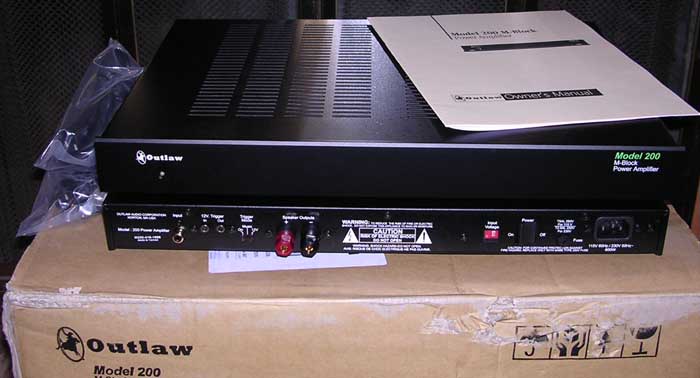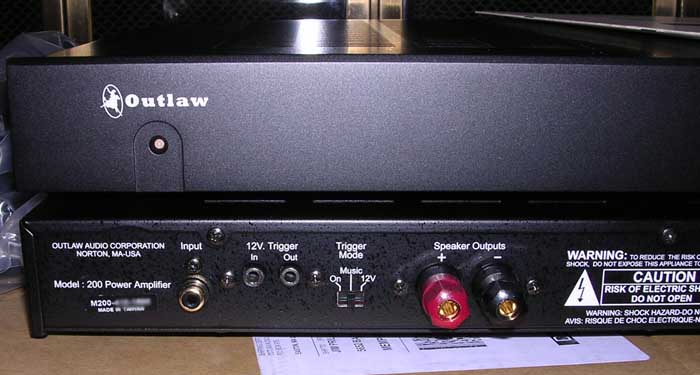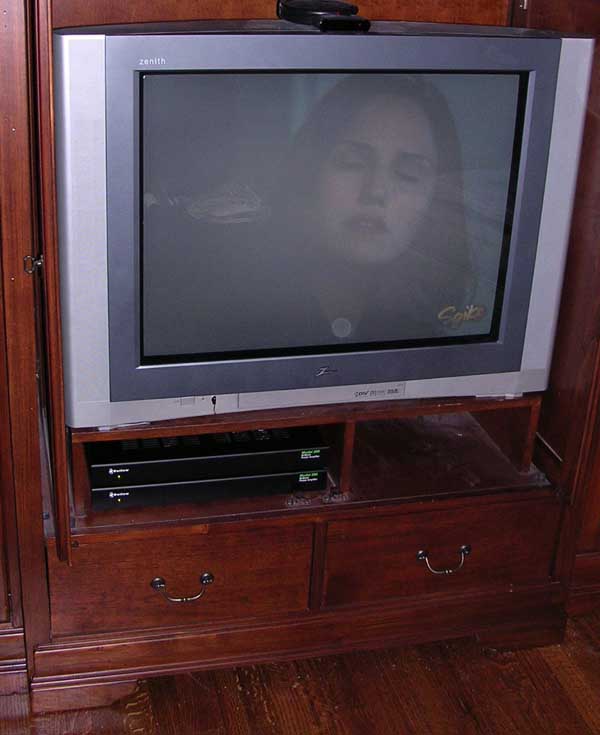

Outlaw Audio has a section of their web forum, the Outlaw Saloon, called "New Product Suggestions" that offers consumers a place to request products that they would like to see from Outlaw. One product idea that was regularly brought up was a monoblock or two-channel amp to complement their multichannel amps. Outlaw got the hint, and in January 2003 they started shipping the Model 200, a 200 watt monoblock amp. The Model 200's slim face (reminscent of a "pizza box" rack-mounted server due to it's 1U form factor) was the first to sport Outlaw's revised logo.
When the Model 200 (or M200, as it is often called) arrived on the market, I had a used Parasound HCA-200 Mk II amp covering the rear surround amplification duties along with my Outlaw Model 750 five-channel amp. The M200 immediately appealed as a potential upgrade, but it was not until quite some time later (after a number of other system upgrades, a move to a new house, and some technical difficulties with the used Parasound) that I was in a position to make the upgrade. After cleaning out some of the equipment in the guest room closet (old Pro Logic receiver, CD changer, and some other odds and ends) in November 2004, I decided it was time to take the plunge.
I ordered the pair of M200's on a Thursday while getting ready to leave town for the weekend, and FedEx Ground tried to deliver the two of them to my back door on the following Tuesday. Unfortunately, FedEx Home Delivery service still hasn't caught on to the fact that many people are at work during the day and therefore can't answer the door at home – they chose to ignore the signature release I have on file and left me a fancy purple and green post-it note instead of my amps (a wholly unsatisfactory substitute). It took a couple phone calls and some wrangling to get sorted out, but we finally got the matter resolved and the amps delivered. Once the M200's arrived, all shipping woes were forgotten. Two boxes were waiting for me on the back step, each with the requisite number of scuffs and bumps from shipping. As with other Outlaw products, the amps were double-boxed, and aside from one dent the inner boxes were unmarred. Dense foam end caps and a foam block over the binding posts kept the amps snug and pristine, and a heavy three-prong IEC power cord was included in each box.


Prior to adding these M200's, I had a Model 750 five-channel amp and an older Parasound HCA-800 Mk II stereo amp. The Model 750 handled the mains, center, and side surrounds, while the Parasound covered the rear surrounds. The M200's were slated to drive the mains, allowing the Model 750 to serve the center and all four surround speakers. This upgrade involved shuffling speaker and pre-amp cables for more than half of the system's channels, which is no simple matter in our entertainment center.

In late 2001, I began preparing to replace my Outlaw Model 1050 receiver with a Model 950 pre/pro, which required me to get some outboard amplification for the rear surround speaker (I already had the Model 750 at that time, but I had six speakers to drive). After briefly using an old Pioneer stereo receiver, I picked up the Parasound HCA-800 amp used (100Wx2 or 200W bridged into mono). I used it in bridged mode to drive a single rear Paradigm Reference Studio/ADP speaker for about two years at our old house, but when we moved to the new house in early 2004 I sold that Studio/ADP and bought a pair of Axiom M3ti's. The M3ti's became side surrounds and the two remaining Studio/ADP's became rear surrounds, both driven by the Parasound. It was then that I ran into problems with the right channel of the Parasound, eventually leading me to drive both Studio/ADP's from the "A" and "B" outputs of the left channel (since the rear surround channels on the Model 950 are mono, this didn't really hurt anything). It was a temporary fix, and setting it up that way heightened my existing interest in the Model 200 monoblocks. I soon decided to replace the Parasound with a pair of Model 200's, but other upgrades and household expenses took priority and it was a long while before I actually got around to doing anything about it. I'd been using the left channel of the Parasound to drive both Studio/ADP's for around ten months when the M200's arrived. The arrangement worked, but I felt that the surround back channels were not performing to their full potential, and I hoped to see an improvement in their performance when the M200's were added and the surround back speakers moved over to the Model 750.
The M200 is a somewhat unusual design. A traditional solid state class A/B 200W amp would generate a great deal of heat, making it very difficult to stack multiple amps closely together without providing some mechanical means of ventilation. And yet, the M200 has no mechanical cooling components: no fans, no heat pipes, no water cooling monstrocities such as might be found in an overclocked PC. This is because the M200 is a hybrid. For the first 80W, the M200 is a traditional class A/B design, at which point it is very similar in design concept to an individual channel from an amp such as Outlaw's Model 7100 (although there does not appear to be any specific design component carry-over between the M200 and Outlaw's other amp products). When asked to produce more than 80W, the M200 switches transparently from class A/B to class G amplification. This transition is reported to take only 2 microseconds (that's 0.002 milliseconds, or 0.000002 seconds) and be completely inaudible. It is this reliance on class G amplification under high demand conditions (which are rare in most cases) that allows the M200 to be so small and to not yield overheating problems when stacked or installed in cramped spaces. But how does it sound? There's one good way to find out...
When the M200's were first installed and the system recalibrated using the Model 950's internal test tones, the first thing that we did was watch some TV – specifically "CSI" and "Without a Trace" on HD cable. More focused listening tests would wait until later, but even this simple offering was quickly revealing. First, the front soundstage seemed slightly cleaner, presumably due in part to having the mains on monoblocks and in part to the center being the only front channel on the multichannel amp (thereby affording its channel all the power it could use). Equally noticeable, however, was the marked change in the surrounds: the dipole surround back speakers (Paradigm Reference Studio/ADP v2's) were clearly working much better once unencumbered by an ailing power amp. Rear effects were clearer and more enveloping. My wife (who had kindly left me alone in the den for the hour and fifteen minutes it took me to get things hooked up) and I both noticed the change immediately. Clearly, the rear surrounds were reacting to the change exactly as I had hoped they would.
The first listening test I did was try some CD's, since that let me listen solely to the M200's. Some of the first discs that I tried out were Tantric's self-titled debut, the Gladiator soundtrack, and Blue Man Group's The Complex. My Paradigm Studio/60's had always matched up well with the Outlaw Model 750, so my goal for CD's was simply to maintain the status quo. If anything, however, I noticed a slightly improved detail with the M200's. Even when cranking the volume up, I heard no change in sonics that suggested problems with the transition from class A/B to class G or with class G operation in general. The amp seems to impart no sonic signature that I could discern, instead doing exactly what a good amp should: amplify the signal and pass it along to the speaker.
In addition to listening to the M200's by themselves, I tried them on some surround material, both multichannel music (DVD-Audio and SACD) and movies. This not only offered a chance to hear them in a fully surround sound environment, it also let me see how the M200's blended with the Model 750 – Outlaw's original power amp, and a purely class A/B design. The first multichannel disc to go in was 3 Doors Down's Away from the Sun DVD-A. As suggested by the first evening's listening, the M200's blend very nicely with the Model 750. The DVD-Audio version of The Complex was equally satisfying, as was the asteroid chase in Attack of the Clones.
The good news: the M200 blends very comfortably and transparently with my other Outlaw amp, despite the fairly different design approach used. The better news: two channel music (already good with the previous arrangement) sounds just slightly more detailed, probably owing to the monoblocks' independent nature. The bad news? Sorry, didn't find any – except maybe the hour of wire-switching involved in installing them in my entertainment center, which certainly isn't the M200's fault.
Outlaw's two flagship products (the now-discontinued Model 1050 receiver released in 2000 and the Model 950 surround sound processor) have garnered much of the attention in Outlaw's product line over the last few years, but it has been their core assortment of power amplifiers that has acted as the heart of the company's line-up. The discontinued Model 750 (5x165W) was their very first product, and the current amp offerings include the Model 770 (7x200W), 755 (5x200W), 7100 (7x100W), and the diminuitive but potent 200 monoblock reviewed here. There's also the Model 790 that is slated to appear in the not too distant future, which will offer a whopping 300W per channel for seven channels. All of the Outlaw amps have consistently received a great deal of respect online and in the print media, as they offer a solid value for a very competitive price.
The Model 200 was originally developed as a great way to expand a home theater from 5.1 to 7.1, since the amps are small and offer enough power to drive most any speaker they might come across. Some people have elected to go a step further and use stacks of M200's to satisfy all of their home theater amplification needs. Five or seven (or more) M200's would make a pretty impressive sight in anybody's equipment rack, but even for those of us looking for a way to drive a couple extra channels, adding a one or two M200's is a very effective solution. It can also be a good solution for someone with a two-channel system who is looking for a little more power – they pack a lot of punch into a small and well-priced package. I found it to be an excellent upgrade and a good complement to my Model 750.